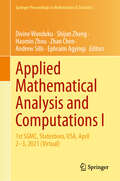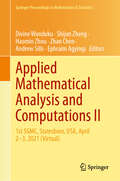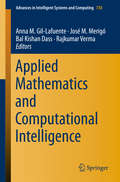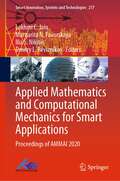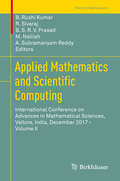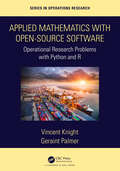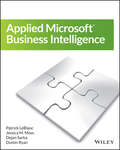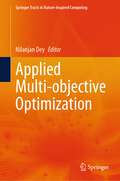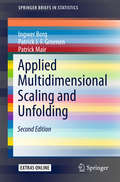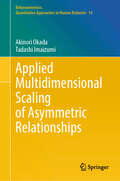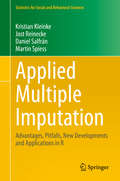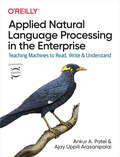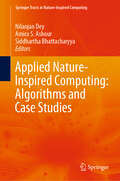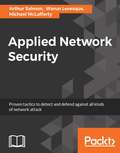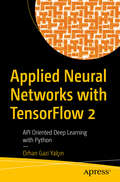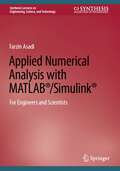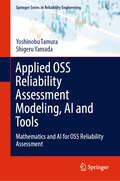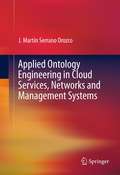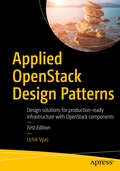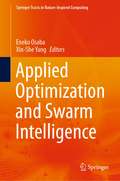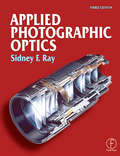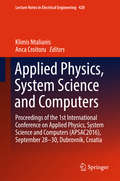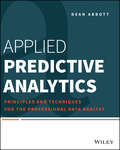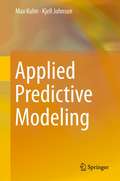- Table View
- List View
Applied Mathematical Analysis and Computations I: 1st SGMC, Statesboro, USA, April 2–3, 2021 (Virtual) (Springer Proceedings in Mathematics & Statistics #471)
by Divine Wanduku Shijun Zheng Haomin Zhou Zhan Chen Andrew Sills Ephraim AgyingiThis volume convenes selected, peer-reviewed research and survey articles that address the modern state-of-the-art in varied areas of applied mathematical analysis. They primarily include presentations as well as invited contributions for the 1st Southern Georgia Mathematics Conference (SGMC) that was virtually held on April 2—3, 2021 at the Georgia Southern University, Statesboro, USA. Papers in this volume incorporate both advanced theory and methods from mathematical analysis, and cover myriad topics like imaging and inverse problems, evolutionary PDEs, symbolic computation, dynamics and data analysis, data science, computational mathematics, and more. This first volume focuses on mathematical analysis theory and applications. These studies and findings contained herein will be of interest to researchers and graduate students working in the fields of mathematical analysis, modeling, data analysis and computation, with applications in many interdisciplinary applied sciences, as in statistics, physics, biology, and medical imaging. They are particularly relevant to those at the forefront of applied mathematical and statistical analysis, as well as data science and other computational science disciplines. In its first edition, the Southern Georgia Mathematics Conference brought together 74 speakers from 70 different institutions, from the USA, Canada, Austria, and Botswana. Attendees included faculty, researchers, experts, graduate and undergraduate students from all over the world.
Applied Mathematical Analysis and Computations II: 1st SGMC, Statesboro, USA, April 2–3, 2021 (Virtual) (Springer Proceedings in Mathematics & Statistics #472)
by Divine Wanduku Shijun Zheng Haomin Zhou Zhan Chen Andrew Sills Ephraim AgyingiThis volume convenes selected, peer-reviewed research and survey articles that address the modern state-of-the-art in varied areas of applied mathematical analysis. They were presented at the 1st Southern Georgia Mathematics Conference (SGMC) that was virtually held on April 2—3, 2021, at Georgia Southern University, Statesboro, USA. Papers in this volume incorporate both advanced theory and methods from mathematical analysis and cover myriad topics such as imaging and inverse problems, evolutionary PDEs, symbolic computation, dynamics and data analysis, data science, computational mathematics, and more. This second volume focuses on modeling, simulation and data analytical studies in the field of computational mathematics. These studies and findings contained herein will be of interest to researchers and graduate students working in the fields of mathematical analysis, modeling, data analysis, and computation, with applications in many interdisciplinary applied sciences, including statistics, physics, biology, and medical imaging. They are particularly relevant to those at the forefront of applied mathematical and statistical analysis, as well as data science and other computational science disciplines. In its first edition, the Southern Georgia Mathematics Conference brought together 74 speakers from 70 different institutions, including the USA, Canada, Austria, and Botswana. Attendees included faculty, researchers, experts, graduate, and undergraduate students from all over the world.
Applied Mathematics and Computational Intelligence (Advances In Intelligent Systems And Computing #730)
by José M. Merigó Anna M. Gil-Lafuente Bal Kishan Dass Rajkumar VermaThis book gathers selected papers presented at the conference of the Forum for Interdisciplinary Mathematics (FIM), held at Palau Macaya, Barcelona, on 18 to 20 November, 2015. The event was co-organized by the University of Barcelona (Spain), the Spanish Royal Academy of Economic and Financial Sciences (Spain) and the Forum for Interdisciplinary Mathematics (India).
Applied Mathematics and Computational Mechanics for Smart Applications: Proceedings of AMMAI 2020 (Smart Innovation, Systems and Technologies #217)
by Lakhmi C. Jain Margarita N. Favorskaya Ilia S. Nikitin Dmitry L. ReviznikovThis book presents best selected research papers presented at the Thirteenth International Conference on Applied Mathematics and Mechanics in the Aerospace Industry (AMMAI 2020), held from September 6 to September 13, 2020, at the Alushta Health and Educational Center (The Republic of Crimea). The book is dedicated to solving actual problems of applied mechanics using modern computer technology including smart paradigms. Physical and mathematical models, numerical methods, computational algorithms, and software complexes are discussed, which allow to carry out high-precision mathematical modeling in fluid, gas, and plasma mechanics, in general mechanics, deformable solid mechanics, in strength, destruction and safety of structures, etc. Technologies and software systems that provide effective solutions to the problems at various multi-scale levels are considered. Special attention is paid to the training of highly qualified specialists for the aviation and space industry. The book is recommended for specialists in the field of applied mathematics and mechanics, mathematical modeling, information technologies, and developers of modern applied software systems.
Applied Mathematics and Scientific Computing: International Conference on Advances in Mathematical Sciences, Vellore, India, December 2017 - Volume II (Trends in Mathematics)
by B. Rushi Kumar R. Sivaraj B. S. R. V. Prasad M. Nalliah A. Subramanyam Reddy<p>This volume is the first of two containing selected papers from the International Conference on Advances in Mathematical Sciences (ICAMS), held at the Vellore Institute of Technology in December 2017. This meeting brought together researchers from around the world to share their work, with the aim of promoting collaboration as a means of solving various problems in modern science and engineering. The authors of each chapter present a research problem, techniques suitable for solving it, and a discussion of the results obtained. These volumes will be of interest to both theoretical- and application-oriented individuals in academia and industry. <p>Papers in Volume I are dedicated to active and open areas of research in algebra, analysis, operations research, and statistics, and those of Volume II consider differential equations, fluid mechanics, and graph theory. </p>
Applied Mathematics with Open-Source Software: Operational Research Problems with Python and R (Chapman & Hall/CRC Series in Operations Research)
by Vincent Knight Geraint PalmerApplied Mathematics with Open-source Software: Operational Research Problems with Python and R is aimed at a broad segment of readers who wish to learn how to use open-source software to solve problems in applied mathematics. The book has an innovative structure with 4 sections of two chapters covering a large range of applied mathematical techniques: probabilistic modelling, dynamical systems, emergent behaviour and optimisation. The pairs of chapters in each section demonstrate different families of solution approaches. Each chapter starts with a problem, gives an overview of the relevant theory, shows a solution approach in R and in Python, and finally gives wider context by including a number of published references. This structure will allow for maximum accessibility, with minimal prerequisites in mathematics or programming as well as giving the right opportunities for a reader wanting to delve deeper into a particular topic. Features An excellent resource for scholars of applied mathematics and operational research, and indeed any academics who want to learn how to use open-source software. Offers more general and accessible treatment of the subject than other texts, both in terms of programming language but also in terms of the subjects considered. The R and Python sections purposefully mirror each other so that a reader can read only the section that interests them. An accompanying open-source repository with source files and further examples is posted online at https://bit.ly/3kpoKSd.
Applied Microsoft Business Intelligence
by Dejan Sarka Patrick Leblanc Jessica M. Moss Dustin Ryanffective enterprise solutionsSearch, analyze, and visualize data more efficiently and completelyDevelop flexible and scalable tabular and multidimensional modelsMonitor performance, build a BI portal, and deploy and manage the BI Solution
Applied Microsoft® Windows® .NET Framework Programming
by Jeffrey Richter<div xmlns="http://www.w3.org/1999/xhtml"><p>Find out all about the .NET Framework common language runtime and learn how to leverage its power to build, package, and deploy any kind of application or component with this book\u2014ideal for anyone who understands object-oriented programming concepts.</p></div>
Applied Multi-objective Optimization (Springer Tracts in Nature-Inspired Computing)
by Nilanjan DeyThe book explains basic ideas behind several kinds of applied multi-objective optimization and shows how it will be applied in practical contexts in the domain of healthcare, engineering design, and manufacturing. The book discusses how meta-heuristic algorithms are successful in resolving challenging, multi-objective optimization issues in various disciplines, including engineering, economics, medical and environmental management. The topic is useful for graduates, researchers and lecturers in optimization, engineering, management science and computer science.
Applied Multidimensional Scaling and Unfolding (SpringerBriefs In Statistics)
by Ingwer Borg Patrick J.F. Groenen Patrick MairProvides a concise, largely conceptual introduction to multidimensional scaling and unfolding.<p><p> Focuses on how to actually run and interpret MDS and unfolding in applied research (with examples from psychology, the social sciences, and market research).<p> Explains with several examples how to use the R-package smacof for MDS/unfolding and Proxscal in SPSS.<p> Includes numerous R-scripts that show how to run MDS and unfolding analyses (a file containing all scripts, and more, can be downloaded).<p>This book introduces multidimensional scaling (MDS) and unfolding as data analysis techniques for applied researchers. MDS is used for the analysis of proximity data on a set of objects, representing the data as distances between points in a geometric space (usually of two dimensions). Unfolding is a related method that maps preference data (typically evaluative ratings of different persons on a set of objects) as distances between two sets of points (representing the persons and the objects, resp.).<p> This second edition has been completely revised to reflect new developments and the coverage of unfolding has also been substantially expanded. Intended for applied researchers whose main interests are in using these methods as tools for building substantive theories, it discusses numerous applications (classical and recent), highlights practical issues (such as evaluating model fit), presents ways to enforce theoretical expectations for the scaling solutions, and addresses the typical mistakes that MDS/unfolding users tend to make. Further, it shows how MDS and unfolding can be used in practical research work, primarily by using the smacof package in the R environment but also Proxscal in SPSS. It is a valuable resource for psychologists, social scientists, and market researchers, with a basic understanding of multivariate statistics (such as multiple regression and factor analysis).
Applied Multidimensional Scaling of Asymmetric Relationships (Behaviormetrics: Quantitative Approaches to Human Behavior #19)
by Akinori Okada Tadashi ImaizumiThis is the first book that focusses the attention on applying asymmetric multidimensional scaling (MDS) and describes how to apply it in a practical manner. The book provides the know-how for prominent methods of asymmetric MDS: analysis of asymmetric relationships and the efficient use of programs of asymmetric MDS based on a distance model. These features will facilitate the work of researchers and enlighten students in disciplines such as statistics, psychology, sociology, education, marketing science, medicine, education, and other fields. Support is provided for practitioners in these areas who are, for instance, developing new products or services, investigating dominance relationships among brands or products, researching the use of antibiotics against resistance bacteria, and developing items for tests. This informative book demonstrates the analyses of data from diverse areas to show how asymmetric relationships are prevalent in real-world relationships and helps readers grasp the meanings and implications of those relationships. The results of the analyses illustrate the importance of analyzing asymmetric relationships that cannot be perceived by analysis using traditional methods, which ignore asymmetry in the data.
Applied Multiple Imputation: Advantages, Pitfalls, New Developments and Applications in R (Statistics for Social and Behavioral Sciences)
by Jost Reinecke Kristian Kleinke Daniel Salfrán Martin SpiessThis book explores missing data techniques and provides a detailed and easy-to-read introduction to multiple imputation, covering the theoretical aspects of the topic and offering hands-on help with the implementation. It discusses the pros and cons of various techniques and concepts, including multiple imputation quality diagnostics, an important topic for practitioners. It also presents current research and new, practically relevant developments in the field, and demonstrates the use of recent multiple imputation techniques designed for situations where distributional assumptions of the classical multiple imputation solutions are violated. In addition, the book features numerous practical tutorials for widely used R software packages to generate multiple imputations (norm, pan and mice). The provided R code and data sets allow readers to reproduce all the examples and enhance their understanding of the procedures. This book is intended for social and health scientists and other quantitative researchers who analyze incompletely observed data sets, as well as master’s and PhD students with a sound basic knowledge of statistics.
Applied Natural Language Processing in the Enterprise
by Ankur A. Patel Ajay Uppili ArasanipalaiNLP has exploded in popularity over the last few years. But while Google, Facebook, OpenAI, and others continue to release larger language models, many teams still struggle with building NLP applications that live up to the hype. This hands-on guide helps you get up to speed on the latest and most promising trends in NLP.With a basic understanding of machine learning and some Python experience, you'll learn how to build, train, and deploy models for real-world applications in your organization. Authors Ankur Patel and Ajay Uppili Arasanipalai guide you through the process using code and examples that highlight the best practices in modern NLP.Use state-of-the-art NLP models such as BERT and GPT-3 to solve NLP tasks such as named entity recognition, text classification, semantic search, and reading comprehensionTrain NLP models with performance comparable or superior to that of out-of-the-box systemsLearn about Transformer architecture and modern tricks like transfer learning that have taken the NLP world by stormBecome familiar with the tools of the trade, including spaCy, Hugging Face, and fast.aiBuild core parts of the NLP pipeline--including tokenizers, embeddings, and language models--from scratch using Python and PyTorchTake your models out of Jupyter notebooks and learn how to deploy, monitor, and maintain them in production
Applied Nature-Inspired Computing: Algorithms and Case Studies (Springer Tracts in Nature-Inspired Computing)
by Siddhartha Bhattacharyya Nilanjan Dey Amira S. AshourThis book presents a cutting-edge research procedure in the Nature-Inspired Computing (NIC) domain and its connections with computational intelligence areas in real-world engineering applications. It introduces readers to a broad range of algorithms, such as genetic algorithms, particle swarm optimization, the firefly algorithm, flower pollination algorithm, collision-based optimization algorithm, bat algorithm, ant colony optimization, and multi-agent systems. In turn, it provides an overview of meta-heuristic algorithms, comparing the advantages and disadvantages of each. Moreover, the book provides a brief outline of the integration of nature-inspired computing techniques and various computational intelligence paradigms, and highlights nature-inspired computing techniques in a range of applications, including: evolutionary robotics, sports training planning, assessment of water distribution systems, flood simulation and forecasting, traffic control, gene expression analysis, antenna array design, and scheduling/dynamic resource management.
Applied Network Security
by Arthur Salmon Michael MclaffertyThis book is for network security professionals, cyber security professionals, and Pentesters who are well versed with fundamentals of network security and now want to master it. So whether you’re a cyber security professional, hobbyist, business manager, or student aspiring to becoming an ethical hacker or just want to learn more about the cyber security aspect of the IT industry, then this book is definitely for you.
Applied Neural Networks with TensorFlow 2: API Oriented Deep Learning with Python
by Orhan Gazi YalçınImplement deep learning applications using TensorFlow while learning the “why” through in-depth conceptual explanations. You’ll start by learning what deep learning offers over other machine learning models. Then familiarize yourself with several technologies used to create deep learning models. While some of these technologies are complementary, such as Pandas, Scikit-Learn, and Numpy—others are competitors, such as PyTorch, Caffe, and Theano. This book clarifies the positions of deep learning and Tensorflow among their peers. You'll then work on supervised deep learning models to gain applied experience with the technology. A single-layer of multiple perceptrons will be used to build a shallow neural network before turning it into a deep neural network. After showing the structure of the ANNs, a real-life application will be created with Tensorflow 2.0 Keras API. Next, you’ll work on data augmentation and batch normalization methods. Then, the Fashion MNIST dataset will be used to train a CNN. CIFAR10 and Imagenet pre-trained models will be loaded to create already advanced CNNs. Finally, move into theoretical applications and unsupervised learning with auto-encoders and reinforcement learning with tf-agent models. With this book, you’ll delve into applied deep learning practical functions and build a wealth of knowledge about how to use TensorFlow effectively. What You'll Learn Compare competing technologies and see why TensorFlow is more popularGenerate text, image, or sound with GANsPredict the rating or preference a user will give to an itemSequence data with recurrent neural networks Who This Book Is For Data scientists and programmers new to the fields of deep learning and machine learning APIs.
Applied Numerical Analysis with MATLAB®/Simulink®: For Engineers and Scientists (Synthesis Lectures on Engineering, Science, and Technology)
by Farzin AsadiThis textbook provides a compact but comprehensive treatment that guides students through applied numerical analysis, using MATLAB®/Simulink®. Ideal as a hands-on source for courses in Numerical Analysis, this text focuses on solving problems using market-standard software, corresponding to all key concepts covered in the classroom. The author uses his extensive classroom experience to guide students toward deeper understanding of key concepts, while they gain facility with software they will need to master for later studies and practical use in their engineering careers.
Applied OSS Reliability Assessment Modeling, AI and Tools: Mathematics and AI for OSS Reliability Assessment (Springer Series in Reliability Engineering)
by Shigeru Yamada Yoshinobu TamuraThis textbook introduces the theory and application of open source software (OSS) reliability. The measurement and management of open source software are essential to produce and maintain quality and reliable systems while using open source software. This book describes the latest methods for the reliability assessment of open source software. It presents the state of the art of open source software reliability measurement and assessment based on stochastic modeling and deep learning approaches. It introduces several stochastic reliability analyses of OSS computing with application along with actual OSS project data. The book contains exercises to aid learning and is useful for graduate students and researchers.
Applied Ontology Engineering in Cloud Services, Networks and Management Systems
by J. Martin SerranoMetadata standards in today's ICT sector are proliferating at unprecedented levels, while automated information management systems collect and process exponentially increasing quantities of data. With interoperability and knowledge exchange identified as a core challenge in the sector, this book examines the role ontology engineering can play in providing solutions to the problems of information interoperability and linked data. At the same time as introducing basic concepts of ontology engineering, the book discusses methodological approaches to formal representation of data and information models, thus facilitating information interoperability between heterogeneous, complex and distributed communication systems. In doing so, the text advocates the advantages of using ontology engineering in telecommunications systems. In addition, it offers a wealth of guidance and best-practice techniques for instances in which ontology engineering is applied in cloud services, computer networks and management systems. Engineering and computer science professionals (infrastructure architects, software developers, service designers, infrastructure operators, engineers, etc.) are today confronted as never before with the challenge of convergence in software solutions and technology. This book will help them respond creatively to what is sure to be a period of rapid development.
Applied OpenStack Design Patterns: Design solutions for production-ready infrastructure with OpenStack components
by Uchit VyasLearn practical and applied OpenStack cloud design solutions to gain maximum control over your infrastructure. You will achieve a complete controlled and customizable platform. Applied OpenStack Design Patterns teaches you how to map your application flow once you set up components and architectural design patterns. Also covered is storage management and computing to map user requests and allocations. Best practices of High Availability and Native Cluster Management are included. Solutions are presented to network components of OpenStack and to reduce latency and enable faster communication gateways between components of OpenStack and native applications. What You Will Learn: Design a modern cloud infrastructure Solve complex infrastructure application problems Understand OpenStack cloud infrastructure components Adopt a business impact analysis to support existing/new cloud infrastructure Use specific components to integrate an existing tool-chain set to gain agility and a quick, continuous delivery model Who This Book Is For: Seasoned solution architects, DevOps, and system engineers and analysts
Applied Optimization and Swarm Intelligence (Springer Tracts in Nature-Inspired Computing)
by Xin-She Yang Eneko OsabaThis book gravitates on the prominent theories and recent developments of swarm intelligence methods, and their application in both synthetic and real-world optimization problems. The special interest will be placed in those algorithmic variants where biological processes observed in nature have underpinned the core operators underlying their search mechanisms. In other words, the book centers its attention on swarm intelligence and nature-inspired methods for efficient optimization and problem solving. The content of this book unleashes a great opportunity for researchers, lecturers and practitioners interested in swarm intelligence, optimization problems and artificial intelligence.
Applied Photographic Optics: Imaging Systems For Photography, Film And Video
by Sidney RaySelected by the American Library Association's 'Choice' magazine as "best technical book", the first edition of this book soon established itself as the standard reference work on all aspects of photographic lenses and associated optical systems. This is unsurprising, as Sidney Ray provides a complete, comprehensive reference source for anyone wanting information on photographic lenses, from the student to the practitioner or specialist working with visual and digital media worldwide. This third edition has been fully revised and expanded to include the rapid progress in the last decade in optical technology and advances in relevant electronic and digital forms of imaging. Every chapter has been revised and expanded using new figures and photographs as appropriate, as well as extended bibliographies. New chapters include details of filters, measurements from images and the optical systems of digital cameras. Details of electronic and digital imaging have been integrated throughout. More information is given on topics such as aspherics, diffractive optics, ED glasses, image stabilization, optical technology, video projection and new types of lenses.A selection of the contents includes chapters on: optical theory, aberrations, auto focus, lens testing, depth of field, development of photographic lenses, general properties of lenses, wide-angle lenses, telephoto lenses, video lenses, viewfinder systems, camera movements, projection systems and 3-D systems.
Applied Physics, System Science and Computers: Proceedings of the 1st International Conference on Applied Physics, System Science and Computers (APSAC2016), September 28-30, Dubrovnik, Croatia (Lecture Notes in Electrical Engineering #428)
by Klimis Ntalianis Anca CroitoruThis book reports on advanced theories and methods in three related fields of research: applied physics, system science and computers. It is organized in two main parts, the first of which covers applied physics topics, including lasers and accelerators; condensed matter, soft matter and materials science; nanoscience and quantum engineering; atomic, molecular, optical and plasma physics; as well as nuclear and high-energy particle physics. It also addresses astrophysics, gravitation, earth and environmental science, as well as medical and biological physics. The second part focuses on advances in system science and computers, exploring automatic circuit control, power systems, computer communication, fluid mechanics, simulation and modeling, software engineering, data structures and applications of artificial intelligence among other areas. Offering a collection of contributions presented at the 1st International Conference on Applied Physics, System Science and Computers (APSAC 2016), the book bridges the gap between applied physics and electrical engineering. It not only to presents new methods, but also promotes collaborations between different communities working on related topics at the interface between physics and engineering, with a special focus on communication, data modeling and visualization, quantum information, applied mechanics as well as bio and geophysics.
Applied Predictive Analytics
by Dean AbbottLearn the art and science of predictive analytics -- techniques that get resultsPredictive analytics is what translates big data into meaningful, usable business information. Written by a leading expert in the field, this guide examines the science of the underlying algorithms as well as the principles and best practices that govern the art of predictive analytics. It clearly explains the theory behind predictive analytics, teaches the methods, principles, and techniques for conducting predictive analytics projects, and offers tips and tricks that are essential for successful predictive modeling. Hands-on examples and case studies are included.The ability to successfully apply predictive analytics enables businesses to effectively interpret big data; essential for competition todayThis guide teaches not only the principles of predictive analytics, but also how to apply them to achieve real, pragmatic solutionsExplains methods, principles, and techniques for conducting predictive analytics projects from start to finishIllustrates each technique with hands-on examples and includes as series of in-depth case studies that apply predictive analytics to common business scenariosA companion website provides all the data sets used to generate the examples as well as a free trial version of softwareApplied Predictive Analytics arms data and business analysts and business managers with the tools they need to interpret and capitalize on big data.
Applied Predictive Modeling
by Max Kuhn Kjell JohnsonThis text is intended for a broad audience as both an introduction to predictive models as well as a guide to applying them. Non-mathematical readers will appreciate the intuitive explanations of the techniques while an emphasis on problem-solving with real data across a wide variety of applications will aid practitioners who wish to extend their expertise. Readers should have knowledge of basic statistical ideas, such as correlation and linear regression analysis. While the text is biased against complex equations, a mathematical background is needed for advanced topics. Dr. Kuhn is a Director of Non-Clinical Statistics at Pfizer Global R&D in Groton Connecticut. He has been applying predictive models in the pharmaceutical and diagnostic industries for over 15 years and is the author of a number of R packages. Dr. Johnson has more than a decade of statistical consulting and predictive modeling experience in pharmaceutical research and development. He is a co-founder of Arbor Analytics, a firm specializing in predictive modeling and is a former Director of Statistics at Pfizer Global R&D. His scholarly work centers on the application and development of statistical methodology and learning algorithms.
